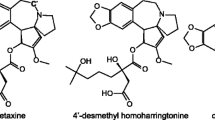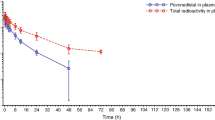Summary
Pyrazine diazohydroxide (NSC-361456) was identified as an active congener of pyridine 2-diazohydroxide with enhanced stability under physiologic conditions. In this phase I study, 35 patients with advanced cancer received 62 courses of PZDH administered intravenously every 3 weeks at doses ranging from 15–608 mg/m2. The dose-limiting toxicity was myelosuppression and the maximal tolerated dose was 487 mg/m2. Hematologie toxicity was delayed and prolonged with median time to recovery about 5 weeks. Mild gastrointestinal toxicity in the form of nausea and vomiting was fairly common. Ondansetron was effective in reducing nausea and vomiting at higher dose levels. Other less common reactions included stomatitis, diarrhea, fatigue, alopecia, and mild abnormalities of renal function and hepatic enzymes. PZDH pharmacokinetics were characterized in 16 patients who received doses of 100–608 mg/m2. Plasma elimination was fit to one (12/16) or two (4/16) compartment model with a mean k10 half-life of 11.5 min. Clearance was dose dependent. Hematologic toxicity was related to PZDH dose, AUC and peak plasma concentration. The sigmoidal relationships between hematologic toxicity and AUC or peak plasma concentration were well described by the Hill equation. There were no objective responses observed in this study. Based on this study, the recommended dose for phase II evaluation of PZDH using this schedule is 390 mg/m2.
Similar content being viewed by others
References
Baker DC, Hand ES, Plowman J, Safavy A, Haugwitz KD, Narayanan VL: Synthesis, chemical stability, and preclinical antitumor activity of pyrazine diazohydroxide, sodium salt (NSC-361456). Anticancer Drug Des 2:297–309, 1987
Fiebig H-H, Dietmar BP, Bernd WR, Plowman J:In vitro andin vivo evaluation of US-NCI compounds in human tumor xenografts. Cancer Treat Rev 17:109–117, 1990
Moore DJ, Brodfuehrer JI, Wilke TJ, Powis G: Disposition and metabolism of the antitumor agent pyrazine 2 diazohydroxide in mouse and beagle dog. Cancer Chemother Pharmacol 21:269–273, 1988
Brodfuehrer JI, Moore DJ, Melder DC, Wilke TJ, Powis G:In vitro cytotoxicity of pyrazine-2-diazohydroxide: specificity for hypoxic cells and effects of microsomal coincubation. Invest New Drugs 6:3–9, 1988
Liao JT, Merriman TN, Collins WT, Smith AC, Kastello MD, Grieshaber CK: Toxicological and pharmacokinetic evaluation of pyrazine diazohydroxide (NSC-361456). Proc Amer Assoc Cancer Res 29:2032, 1988
Wilke TJ, Kooistra KJ, Moore DJ, Powis G: Gas Chromatographie assay for the new antitumor agent pyrazine-2diazohydroxide (diazohydroxide) and its stability in buffer, blood and plasma. J Chromatogr 388:77–83, 1986
Du D-L, Volpe DA, Grieshaber CK, Murphy MJ: Comparative toxicity of fotriecin, hepsulfam, and pyrazine diazohydroxide to human and murine hematopoietic system. Invest New Drugs 9:149–157, 1991
Harrison SD, Plowman J, Dykes D, Waud W, Griswold D: Schedule dependence, activity against natural metastases, and cross resistance of pyrazine diazohydroxide (sodium salt NSC 361456) in preclinical modelsin vivo. Cancer Chemother Pharm 25:425–429, 1990
Gibaldi M, Perrier D: Pharmacokinetics. 2nd edition, Marcel Dekker, Inc., New York, NY, 1982, pp 409–416
Wagner JG: Kinetics of pharmacologic response. I. Proposed relationships between response and drug concentration in the intact animal and man. J Theoret Biol 20:173–201, 1968
Sheiner LB, Beal SL: Some suggestions for measuring predictive performance. J Pharmacokin Biopharm 9:503–512, 1981
Supko JG, Balcerzak SP, Kraut EH: Phase I evaluation and pharmacokinetic study of pyrazine-2-diazohydroxide administered as a single bolus intravenous injection in patients with advanced solid tumors. Cancer Res 53:4843–4849, 1993
Vogelzang NJ, Janisch L, Berezin F, Mick R, Schilsky R, Walter P, Ratain MJ: Pyrazine diazohydroxide (PZDH): A phase I trial. Proc Amer Assoc Cancer Res 33:3182, 1992
Rowinsky EK, Grochow LB, Hendricks CB, Ettinger DS, Forastiere AA, Hurowitz LA, Mc Guire WP, Sartorius SE, Lubjeko BG, Kaufman SH, Donehower RC: Phase I and pharmacologic study of topotecan: a novel topoisomerase I inhibitor. J Clin Oncol 10:647–656, 1992
Egorin MJ, Van Echo DA, Whitacre MY, Forrest A, Engish KL, Aisner J: Human pharmacokinetics, excretion, and metabolism of the anthracycline antibiotic menogaril (7-OMEN, NSC 269148) and their correlation with clinical toxicities. Cancer Res 46:1513–1520, 1986
Egorin MJ, Sigman LM, Van Echo DA, Forrest A, Whitacre MY, Aisner J: Phase I clinical and pharmacokinetic study of hexamethylene bisacetamide (NSC 95580) administered as a five day continuous infusion. Cancer Res 47:617–623, 1987
Ratain MJ, Schilsky RL, Conley BA, Egorin MJ: Pharma codynamics in cancer therapy. J Clin Oncol 8:1739–1753, 1990
Author information
Authors and Affiliations
Rights and permissions
About this article
Cite this article
Dhodapkar, M.V., Richardson, R.L., Reid, J.M. et al. Pyrazine diazohydroxide (NSC-361456). Invest New Drugs 12, 207–216 (1994). https://doi.org/10.1007/BF00873961
Issue Date:
DOI: https://doi.org/10.1007/BF00873961




